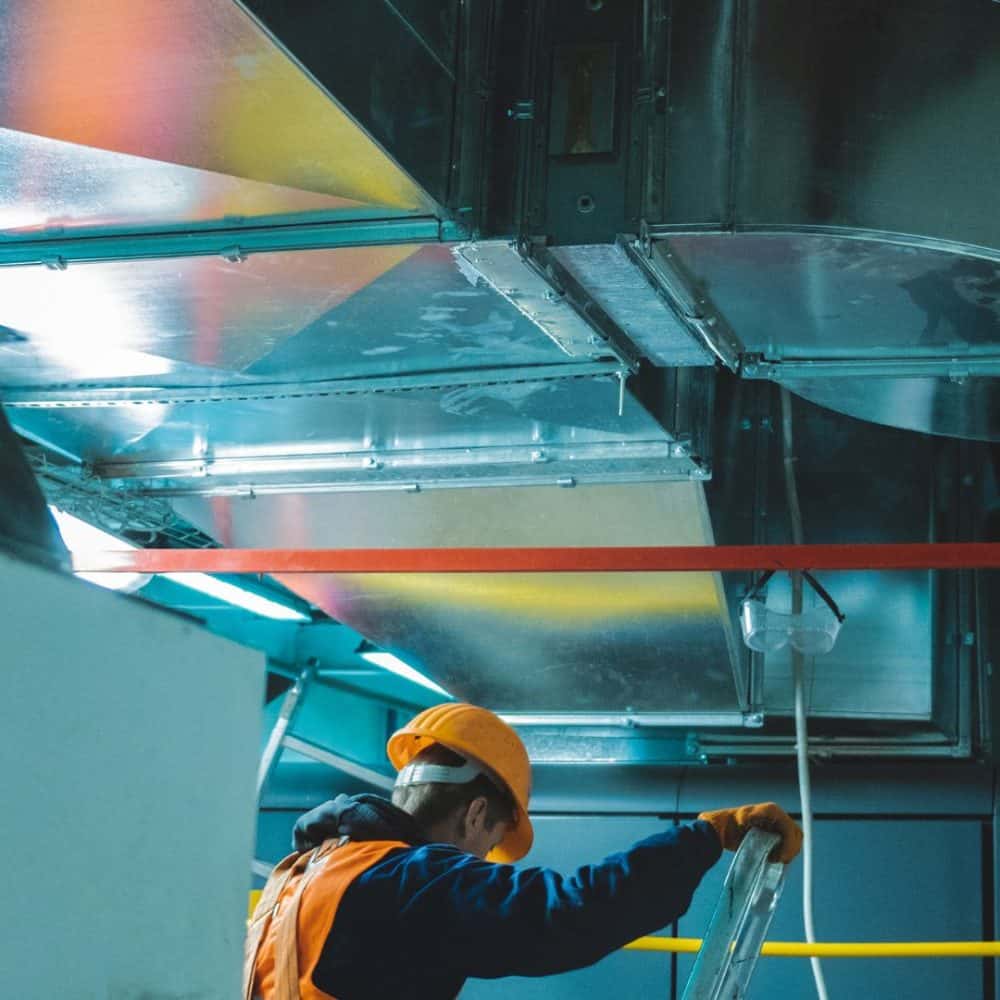
Trakref
What's the Future of Environmental Health and Safety?

A bit of background on environmental health and safety, especially around HVAC/R
Historically HVAC/R owners/Operators have had the responsibility to track refrigerants only if systems contained 50 pounds or more of refrigerant. Refrigerants are a class of chemicals used in cooling equipment that can cool, people, places, food, or a production process.
Additionally, refrigerants may be referred to as F-gasses or fluorinated compounds.
For nearly three decades, the industry has used the same tools and processes and relied on the same basic understanding of refrigerants.
EHS (Environmental Health & Safety Team members) rely on their counterparts in the HVAC/R department to annually provide them with information that they pull from maintenance records collected throughout the year from their Computerized Maintenance Management System (CMMS) systems.
This existing systematic approach is now changing due to market forces in the investment community seeking better information to accommodate investor demands.
Although we are in the 4th generation of refrigerants, direct emissions of leaks have not slowed at all. Leaks occur at regular intervals throughout the HVAC/R system life, and they impact performance, efficiency, and the environment. Leaks occur at commissioning, throughout the active lifecycle, and during shutdown, growing more common as the units get older. Regardless of how hard an organization works, leaks still happen from refrigeration and air conditioning systems; these leaks are direct emissions, otherwise known as fugitive emissions, to the reporting world.
The people responsible for maintaining the appliance’s operation are the SMEs (Subject Matter Experts) in organizations. The people responsible for reporting are the SMEs of the EHS team. They are responsible for leading programs that protect people from environmental hazards and workplace hazards, as well as protect the environment from human hazards Role.
With environmental health and safety, everything is in motion
Regulations are changing, ESG reporting demands are changing, and names and terms are changing. For instance, recently, at the latest National Association for EHS&S Management (NAEM) conference, the topic of discussion was how the role of the EHS (Environmental, Health, and Safety) manager is transforming into EHS&S manager, where the extra ‘S’ isn’t for Savings, but Sustainability.
Sustainability Added to EHS
Sustainability was added to EHS because the (E) environmental part was about complying with regulations to prevent toxins and pollutants from entering the environment. Sustainability is focused on the impact a business has on the environment and society. Even though the environmental component considers carbon footprint, sustainability goes further into considering how a business is impacting the environment.
Is the future of environmental health and safety truly just about people working together more?
In the past, the EHS and HVAC/R or facility teams would meet annually. A top-level review of the direct emissions would usually only include HVAC/R appliances that were 50 pounds and over, and the EHS teams would then assess the scope of regulations impacted by their organization’s “refrigeration” footprint. Now, however, the scale and scope are expanding to include assets with less than 50 pounds of refrigerant. And it is more than just refrigeration. The process is to now report on comfort cooling and product cooling of all sizes.
As EHS managers adapt to meet the new sustainability needs and expanded resources required to adhere to regulatory reporting requirements, the planning must include new practices integrated into operations. EHS&S teams are now expected to develop and share new knowledge with their counterparts in HVAC/R and facilities. This means rewriting policies, developing new controls, and creating more robust governance while remaining relevant to facilities and the HVAC/R management process. The challenge for EHS&S teams is that they have reporting responsibility, but no control over the programs they are responsible for reporting.
The HVAC/R and facilities teams will now be expected to provide accurate asset information and details related to tracking and reporting refrigerant usage. Accurate reporting of refrigerant emissions is not easy, so there are several evolving methodologies like the GHG protocol, TCFD, IPCC, and TCR that will need to be evaluated as management considers which profile to follow when assessing the material risk to operations.
Materiality and the HVAC/R spectrum
Since 2004, companies have published ESG reports, including Scope 1 and Scope 2 emissions. To a large extent, the reports have been mostly marketing oriented, and the responsibility has been assigned to marketing teams because the reports were most useful to show how an organization cared about the environment or their community, essentially providing companies an opportunity to profile their status of good citizens. But that role is shifting from aspirational to operational as investors use these reports to guide the potential for investment.
HVAC/R appliances often account for 30% or more of a company’s energy and maintenance spending. Both of these factors are heavily impacted by emissions. Refrigerants have a high GWP factor, meaning that one pound of refrigerant can equal one or more TONS of carbon. So emissions have a 4 fold impact on maintenance costs, energy spending, equipment life, and the environment. Regulations have not slowed emissions; and therefore, sustainability reporting is evolving to keep pace with the emissions tracking so that investors can determine if a company is investing in its infrastructure wisely or not.
Organizations that report Scope 1 & 2 emissions have proven to run more efficient equipment, with a higher level of performance success and lower impact to the environment.
Scope 1 Emissions
Scope 1 emissions are greenhouse gas released on an organization’s site or from their boilers, HVAC/R units, and vehicles. More accurately, they are CO2e (Carbon Dioxide Equivalent) emissions from sources owned or controlled by an organization. Typically these are emissions generated by HVAC/R leaks, gas (or oil) used in boilers, and owned or leased cars, vans & trucks.
Scope 2 Emissions
Scope 2 emissions are indirect GHG emissions associated with purchasing electricity, steam, heat, or cooling.
Environmental health and safety: Tactics vs. strategy
The tactic here is to be able to collect data and report; the strategy should be lower refrigerant emissions rates. We have been involved in more than 50 Scope 1 & 2 emissions reporting implementations, and in each case, we have spent more time assessing and improving the data collection than we have in determining the goals. Company executives are increasingly worried about their Scope 1 and 2 emissions results since it can impact their compensation. Companies are focused on protecting their investments from risk since any risk will impact their share value. Shareholders are using performance on Environmental, Social, and Governance (ESG) or non-financial matters as a key metric when determining the value of the senior leadership of the firms they invest in.
This tactic aligns leadership with investment goals and ensures that all parties are synced on the important things. Non-financial matters can also indicate how a company performs at the operational level since maintenance spending is often reduced when profits run lean. Companies will have to do more to rank their budgeting programs to reflect their impact on ESG outcomes.
One relatively simple way to get started around environmental health and safety
Equipment lists or registries of HVAC/R appliances likely already exist for your firm, so start there. Determine your installed inventory and then learn about the regulations at the federal and state levels. Examples include Law 97 in NY, EPA 608, the AIM act, or NJ 7:27. To all the EHS professionals out there, be open to a discussion with your HVAC/R team counterparts about the importance of the data. But be mindful that there will be gaps in the data, because their teams are likely short-handed, and they might not be ready to meet with you more than one time per year.
HVAC/R teams, imagine a scenario where the CEO or the entire company might not achieve their goals without more data delivered more frequently. But also imagine a new opportunity to tell your story about that leaky unit you have wanted to replace for five years. Now, because it leaks over the company threshold, you can get the budget to fund its retrofit or replacement.
Materiality is a concept that defines why and how certain issues are important for a company or a business sector. A material issue can have a major impact on the financial, economic, reputational, and legal aspects of a company, as well as on the system of internal and external stakeholders of that company.
The materiality assessment comes first and must include key stakeholders, such as facilities, outside vendors (where applicable), finance, and EHS&S teams. Materiality in principle, will help define and determine the HVAC/R business and environmental topics that matter most to each business and its stakeholders. For instance, there are key materiality issues that all businesses should be including in their disclosures related to the forced replacement or retrofit of certain assets due to the accelerated obsolescence of key refrigerants, taking place long before appliances will meet their depreciation lifecycle as defined in the AIM act of 2020.
The carbon balance sheet
If we take a page from the financial world, developing a special facility-based balance sheet for material transfers could be a useful resource to assess your companies status. A balance sheet is prepared to report an organization’s financial position at the end of an accounting period, such as midnight on x day. But organizations now need a new balance sheet to assess material impacts, and we suggest using a carbon balance sheet.
From a refrigerant and HVAC/R perspective, this balance sheet (already available to Trakref clients) provides visibility into the transactional impact that refrigerants can have on your company’s carbon footprint, which also impacts market status, bonuses, and share value.
Environmental health and safety: The possible vs. the potential
There are many factors driving sustainability, and wider environmental and social governance (ESG) issues to the top of your agenda: government incentives and regulations; investor standards; customer sentiment, and the views of your workforce and broader society. Evaluating material risk is the key to setting goals for your company.
Many people reading this have not kept up with all the changes in regulations or the rapid pace of ESG adoption; that’s why the path to better decision-making should not be long or complicated. It is simply a matter of untangling the cross-web of existing operational siloed responsibilities and accountability one activity at a time. Follow the path of successful companies like Amazon, Google, and Spotify and become flatter and more agile. Find partners to help you come up to speed and resources like Trakref with a proven track record and get expertise into your team while retaining the decision-making power internally. This agile approach will change your company’s velocity at setting and reaching goals.
Keep in mind that if you continue to use only internal resources, then certain categories will likely be overlooked and cause your organization to restart its initiative so you must consider this: “are you in a position to allow a delay?”
The biggest challenge around ESG reporting (an impediment to environmental health and safety) is data accuracy
Currently, there are gaps in what companies understand their emissions and what they are. This is because most companies are lacking an understanding of how many assets they have under their control. HVAC/R professionals can attest to this firsthand. This is likely due to the discrepancy between a company’s obligated assets and installed capacity.
Federal, state, and local regulations only impact 5% of all HVAC/R appliances. Your team has only been tracking a small portion of the assets containing refrigerants.
Federal refrigerant regulations
Federal regulations require you to track a limited amount of data related to certain refrigerant types. The EPA requires that: “Owners or operators of appliances that contain 50 or more pounds of ozone-depleting refrigerant must keep servicing records documenting the date and type of service, as well as the quantity of refrigerant added. Owners or operators must also maintain records of leak inspections and tests performed to verify leaking appliance repairs.
ESG reporting
The SEC will soon require accurate ESG disclosures for publicly traded companies. Fortunately, these requirements mirror those of the EPA. So if a company adopts a solid ESG program, it will most likely be the way to SEC compliance.
State level and local level
Certain states such as NJ, Washington, and California, have their registration, reporting, and record-keeping standards. If you have assets in those states, it is critical to understand and adhere to this refrigerant reporting and record-keeping requirements. And for companies listing internationally or with assets in Europe, there are additional requirements for the EU.
How Trakref fits into the bigger picture of environmental health and safety around HVAC/R
Refrigerant management, when successful, lowers energy use, helps find new resources for maintenance teams and aligns the ways businesses operate with the expectations of shareholders and the C-Suite. But refrigerant management requires buy-in from all sides. Company Leadership is driving the ESG initiatives, and with support from EHS&S, HVAC/R, and facilities professionals, success is possible.
The old way of doing business is going away. Gone will be the days of refrigerants being vented into the atmosphere without consequence. Refrigerants have an impact, and companies are starting to understand that. Trakref is here to help EHS&S and HVAC/R professionals transition to the new way of doing business.
Our sector and functional depth of experience and the breadth of our integrated multidisciplinary capabilities have been tested, validated, and exposed to 28 years of practical development. We understand that every business has highly differentiated ESG challenges, and we remain focused on real-world practical pathways to being an integral part of your team’s operational, compliance and sustainability success.



